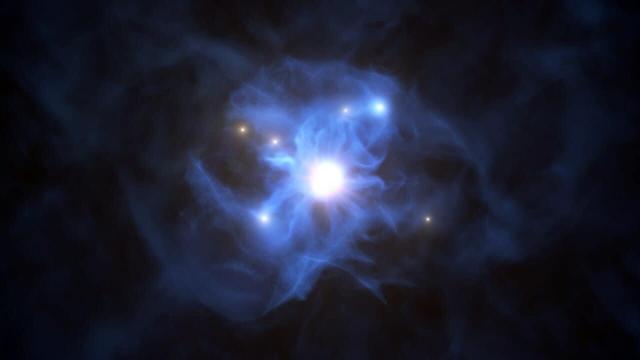A remote structure consisting of a supermassive black hole, several primordial galaxies, and copious amounts of gas finally explains how some of the earliest black holes were able to grow so quickly.
The deeper we look into space, the further we look back into time. In this case, astronomers have caught a glimpse of the universe when it was just a toddler — a mere 900 million years after the Big Bang. Using a batch of powerful telescopes, and after a decade’s worth of astronomical observations, an international team of scientists has confirmed the presence of multiple primordial galaxies caught under the influence of an unusually large and bright supermassive black hole, the light from which took 12.9 billion years to reach Earth.
“This is the first spectroscopic identification of a galaxy overdensity around a supermassive black hole in the first billion years of the Universe,” wrote the researchers in their study, published today in Astronomy & Astrophysics. The “absence of earlier detections of such systems is likely due to observational limitations,” they added.
Indeed, astronomers have never seen this sort of thing before, but it’s not entirely unexpected, as the astral arrangement is helping to explain the early appearance of supermassive black holes. As the new research suggests, these web-like structures provided a gas-filled environment in which the first black holes were able to feed and grow.
“The galaxies stand and grow where the filaments cross, and streams of gas — available to fuel both the galaxies and the central supermassive black hole — can flow along the filaments,” explained Marco Mignoli, the lead author of the study and an astronomer at the National Institute for Astrophysics (INAF) in Italy, in an European Southern Observatory statement.
To find and confirm this structure, Mignoli and his colleagues used some of the most powerful telescopes in the world, including the ESO’s Very Large Telescope in Chile, the space-based Hubble telescope, the Keck II observatory in Hawaii, among others.
The supermassive black hole is active, hosting a quasar known as SDSS J1030+0524, and it’s also very heavy, with the mass of a billion Suns. Caught loitering around the black hole are at least six star-forming galaxies. The entire web-like structure is approximately 300 times the size of our Milky Way galaxy. Early large-scale structures such as this have cores that eventually evolve into gigantic galaxy clusters, according to the paper.
The purpose of this investigation was to study the earliest supermassive black holes in the universe, as there’s no good explanation for their existence. The first black holes to appear arose from the collapse of the very first stars — that much makes sense. But for these black holes to expand to supermassive status and achieve a billion solar masses within the first 0.9 billion years of the universe’s existence, well, that requires an explanation. The newly discovered large-scale structure finally provides a mechanism for how this likely happened.
[referenced id=”1442554″ url=”https://gizmodo.com.au/2020/09/funky-discrepancy-deepens-dark-matter-mystery/” thumb=”https://gizmodo.com.au/wp-content/uploads/2020/09/12/jqltdqescdyddyvsgave-300×168.jpg” title=”Funky Discrepancy Deepens Dark Matter Mystery” excerpt=”New research, in which empirical data failed to jibe with theoretical calculations, shows just how much physicists still have to learn about dark matter.”]
As the researchers speculate, these web-like structures formed and grew within giant halos of dark matter. These immense regions of invisible matter attracted tremendous amounts of gas during the early phase of the universe, in a process that created the conditions under which these web-like structures could form. This in turn gave rise to galaxies and supermassive black holes.
The researchers documented six galaxies around the black hole, but they hope to find more. The ESO’s Extremely Large Telescope will be recruited for the task once construction is complete.
